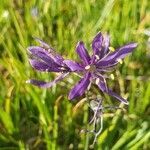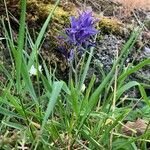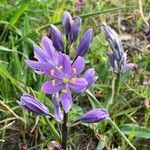A plant with a bulb. It keeps growing from year to year. It grows 25-90 cm high and 10-15 cm wide. It has grass-like leaves. It forms large clumps. The leaves are blue-green and 50 cm long. They all grow from the base and are 5-15 mm wide. The flower spikes are blue. The flowers are 5 cm across. The flowers are star shaped. The fruit are dry capsules with shiny black seeds. The bulbs are 3-5 cm across. The bulb is edible.



